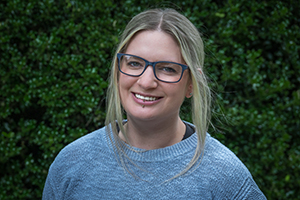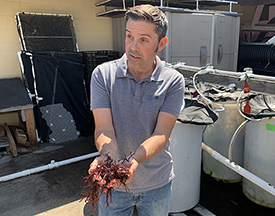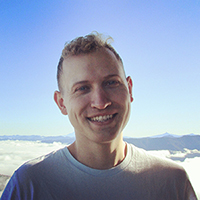Zoe Almeida
Zoe has moved on to a Senior Research Associate position with Cornell University at their Biological Field Station on Oneida Lake. She is working in partnership with the university and New York State Department of Environmental Conservation to study warm water fish populations throughout the inland waters of the state and how they are responding to Climate Change, eutrophication, and invasive species.
Keep up with Zoe via GoogleScholar or on Twitter.
Samreen Siddiqui
Samreen was a postdoctoral scholar in Brander lab from August 2020 to August 2022. She was part of multiple projects while working here including NSF funder micro nano plastics (MNP) impacts on model estuarine indicator species. Samreen developed an efficient microfiber generation technique with economic approach of using coffee grinder in lab. She also developed weathering technique in lab for MNP exposures. In addition, Samreen demonstrated leadership skills and served OSU postdoctoral association as president, after serving as membership coordinator for a year. Samreen was also an OSU Diversity and Inclusion committee member, Scholarship committee member, and Web & Outreach committee member. Additionally, Samreen is serving as an Editorial board member of IEAM (Integrated Environmental Assessment and Management) and IJEST (International Journal of Environmental Sustainability and Green Technologies). Samreen also served Oregon Sea Grant as an ORSEA Scientist and prepared an activity for K-12 students to make them aware of plastic pollution.
Samreen is now moving to California Department of Fish & Wildlife as Environmental (Data) Scientist, where she will be working on fish population data.
Keep up with Samreen via her Web Page, Google Scholar or follow her on Twitter @Dr_SSiddiqui
Fabio Caltabellotta
Fabio was a postdoctoral research associate in Will White's lab from May 2020 - July 2022. Fabio was the lead researcher on an ongoing project designed to improve the accuracy of fishery stock assessments. During his postdoc, he also served as Oregon Department of Fish and Wildlife (ODFW) representative on the Scientific and Statistical Committee (SSC) on the Pacific Fishery Management Council. Fabio’s research primarily focuses on determining how bias in the growth parameters impacts fishery stock assessments. He is using an age- and length-based simulation model in a Bayesian Framework to assess how to adjust fishery stock assessment methods to consider the effect of the aforementioned uncertainties.
Fabio has moved on to a new postdoc appointment at Florida State University Coastal and Marine Laboratory (FSUCML), where he is primarily working on developing decision-support tools to guide management and restoration of the Apalachicola Bay ecosystem.
You can keep up with Fabio through ResearchGate and Google Scholar.
Laura Storch
Laura was a postdoctoral scholar in Will White's lab from August 2019 - August 2022. Laura's work in the lab focused on modeling Eastern oyster (Crassostrea virginica) population dynamics in order to better inform management and restoration efforts. In one project, she examined population heterogeneity within and across estuaries on the Floridian west and east coasts. She also investigated lack of recovery of oyster populations in Apalachicola Bay following a hurricane.
Laura has moved on to an Assistant Professor appointment with the Mathematics Department at Bates College in Lewiston, Maine. She will continue her research in using mathematical tools to understand complex spatiotemporal dynamics of ecosystems and populations, and looks forward to guiding her own research projects and mentoring student research.
Keep up with Laura via Google Scholar or her personal website.
Craig Norrie
Craig was a postdoctoral scholar in Jessica Miller’s lab from February 2020-April 2022. His primary research focused on the relationships between size, growth, and survival of juvenile Columbia River Chinook Salmon during their first few weeks of ocean residence – a particularly dangerous time and place to be a young salmon. He used the microchemical composition and structure of otolith to reconstruct patterns of size and growth prior to, and after ocean entry. Additionally, during his time with COMES, Craig conducted research to investigate the impacts of interacting temperature and ocean acidification stress on the chemical composition of staghorn sculpin otolith.
Craig has moved on to a new postdoc appointment at the University of Washington where he is investigating the influence of interacting climate change stressors on farmed oysters. As part of this research, he hopes to help the aquaculture industry in the Pacific Northwest adapt to a changing climate.
Keep up with Craig via his personal website or Twitter.
Matthew Hawkyard
Matt Hawkyard has a long history with the Coastal Oregon Marine Experiment Station. He began his career in Chris Langdon’s lab as a MS student in 2007(!), earned his Ph.D. in 2016, and worked tirelessly as a research associate until 2021. Matt made great contributions in the areas of micro-encapsulated particulate larval diets for use in finfish aquaculture and disease control in finfish aquaculture. In addition, Matt demonstrated increasing leadership on transdisciplinary aquaculture projects at Oregon State University, including serving on the OSU Aquaculture committee and working on the Oregon Aquaculture Explorer project with the OSU Institute of Natural Resources.
Matt’s accomplishments at OSU have paved the way for him to continue his success as Assistant Extension Professor and Finfish Nutrition Specialist at the University of Maine’s Aquaculture Research Institute. He’ll be increasing his knowledge of salmon nutrition in his new position, but also looks forward to having the flexibility to pursue his own research interests.
Keep up with Matt via Google Scholar.
Felix Vaux
Felix was a postdoctoral research associate in the State Fisheries Genomics Lab under the direction of Dr. Kathleen O'Malley from January 2018-October 2019. His primary research centered on population genomic variation in Pacific albacore tuna (Thunnus alalunga) and investigating potential implications for the fisheries management of the species. Additional areas of research during his time with COMES included neutral and adaptive genomic markers in Arctic charr (Salvelinus alpinus), otolith shape and genomic variation in Deacon rockfish (Sebastes diaconus) and sex identification markers in eight species of rockfish (Sebastes).
Felix has gone on to a new postdoc appointment at the University of Otago in Dunedin, New Zealand, where he is testing the ‘founder takes all’ hypothesis on earthquake uplifted shores in New Zealand and Chile using population genomics and phylogenetics.
Keep up with Felix via Google Scholar or ResearchGate, or follow him on Twitter.







